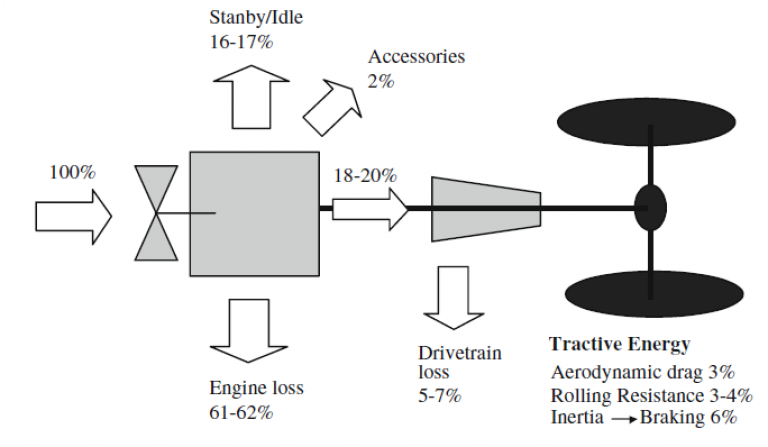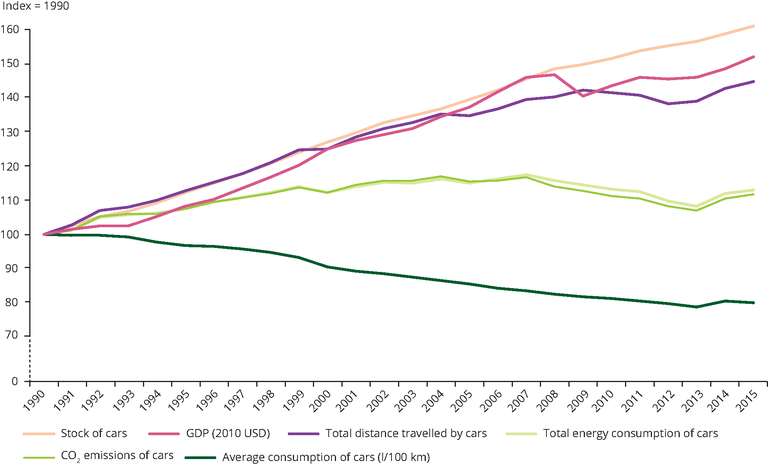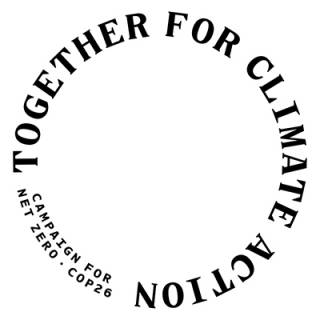Energy efficiency – the first fuel
10 August 2021

At a glance
- There are great opportunities for increasing energy efficiency across buildings, industry and transport
- Strong and consistent government policy will be required to realise these opportunities
- Different policies will be required in the different sectors, there is no magic bullet for increased energy efficiency
- Mandatory standards and regulations will be required in the different sectors, as well as policy instruments that charge for the pollution caused by the use of fossil fuels
What is the problem?
The energy we use in our homes, industry, vehicles and appliances has been through several stages of transformation. Natural resources (sunlight, wind, uranium, crude oil and other fossil fuels – so called ‘primary energy’) are converted into useful forms: petrol, diesel, electricity (so-called ‘final energy’). This is then transported to where it is needed. This is then used to deliver an ‘energy service’: transport from A to B, clothes washed, homes heated and entertainment watched, kettles boiled, streets lit.
At each stage energy is wasted, so that the useful energy that actually delivers the services we want is a fraction, often a small fraction, of the primary energy input. Money is wasted along with energy. Larger investments in energy supply are made than are strictly necessary, making energy more expensive. Where the primary energy is a fossil fuel, more CO2 is emitted than the delivery of the energy services requires.
Increasing energy efficiency along the chain of energy production, transport and use reduces the fraction of wasted energy and the negative consequences that go along with it.
What are the key characteristics of the problem?
In many sectors, energy use represents a relatively small proportion of costs, so there is little incentive to use it efficiently. Many buildings were constructed before the 1970s, when energy was relatively cheap. Buildings and much machinery are long-lasting, and retrofitting it for greater energy efficiency can be expensive. All these factors mean that the economic incentives to increase the efficiency of energy use in these sectors are weak.
These weak incentives are accompanied by market failures that further inhibit energy efficiency measures. Fossil energy, in particular, is cheaper than it should be because its prices in the market all too often do not account for the pollution it causes. In fact, many countries actually subsidise fossil fuels, making them even cheaper than they would be in unregulated markets. In some markets energy efficiency investments are further discouraged because the investor finds it difficult to benefit from energy savings from greater energy efficiency (e.g. in buildings where the landlord has to make the investment, but the tenant pays the energy bills).
There can be further problems related to energy efficiency technologies. The measures required to increase energy efficiency are different across different sectors and regions, which prevents a widespread understanding of what needs to be done. Many people and businesses do not know what technologies are available to increase energy efficiency, and engineers and installers of energy technologies, especially in buildings, are often not trained in how to install them effectively. Perhaps because of low general awareness of energy efficiency, energy efficiency tends to have a low priority in people’s purchasing decisions, whether of buildings, vehicles or appliances, and therefore energy efficiency labels, where they are available, have a limited influence.
As a result of these and other factors, the delivery of energy efficiency in buildings has not been able to reach its potential despite attempts to address this from various angles; older buildings, particularly traditional and heritage buildings, may require different approaches than their contemporary counterparts; in vehicles substantial gains in the energy efficiency of engines has not been converted into increased miles per gallon because of the increase in the size and weight of the vehicles purchased; in energy-intensive industry competitive pressure has caused resistance to efforts to tax fossil energy for the pollution it causes; and in other industry energy efficiency remains a low priority for both analysis and investment.
What is the solution?
Increased energy efficiency in the UK has already played a major role in reducing carbon emissions. Lees and Eyre (2021) calculated that between 1989 and 2019 it saved 224 million tonnes of CO2, over three times as much as the switch from coal to gas in power generation in the 1990s, or the more recent growth of power generation from renewables. They identify the key changes responsible for these savings as major increases in building energy efficiency, and higher efficiency boilers, vehicles and appliances. The UK Climate Change Committee has also identified product standards set at an EU level as an important driver of energy efficiency, and emissions reductions in lights, appliances and vehicles. Lees and Eyre also note that effective energy efficiency policies have generally focused on individual sectors and even technologies, and use a wide range of policies, including regulation, incentives and information.
However, there is considerable further potential for increased energy efficiency in buildings, transport and industry, which both the International Energy Agency and the UK Climate Change Committee regard as essential for meeting both global and the UK’s CO2 reduction targets. Measures to increase energy efficiency differ between these sectors, which will be discussed separately below. But for all sectors, causing the users of fossil fuels to pay for the pollution they are causing, for example by taxing polluting fuel use, would increase the economic attractiveness of energy efficiency investments.
Industry
‘Industry’ is diverse and increasing energy efficiency in different industrial sectors requires a specific and targeted approach. However, in general terms the means of improving industrial energy efficiency are well known, but all too often not adopted in businesses that could benefit from them. They include: support at Board level, especially from the Finance Director; appointing an internal energy management team, to draw up a plan to monitor and reduce energy usage, and implement energy-saving ideas, with incentives and bonuses based on performance; carrying out energy audits to identify the business’s hotspots of energy use; controlling and managing the use of machinery; and increasing the use of energy-efficient lighting. Benchmarking energy efficiency in different sectors can show up the difference in business performance and highlight the potential for improvement, and governments can require companies over a certain size to report on their energy efficiency actions each year, and promote industrial energy efficiency through regional targets, financial support, and specific regulation and standards.
Buildings
Energy efficiency in homes (the domestic sector) and commercial and public buildings (the non-domestic sector) provides many opportunities for CO2 emissions reductions. It is also associated with a wide range of other positive impacts or ‘co-benefits’, such as improved health, productivity and social welfare of occupants in addition to increased employment opportunities in the energy efficiency industry. Energy efficiency measures for buildings include: cavity-wall, solid wall and loft insulation; draught proofing and improved glazing; replacement of old gas boilers (with either more efficient condensing gas boilers or heat pumps); and more energy-efficient appliances, air conditioning systems, hot-water tanks, heating systems and light bulbs; and, for commercial buildings, energy management systems.
Achieving increased energy efficiency in buildings involves the detailed consideration together of all the complex factors which influence energy consumption, including the building fabric, the systems and equipment/appliances installed in it and, most importantly, the people who occupy it. Effective energy efficiency policies have included minimum standards and labelling, and a wide range of regulations and voluntary certification schemes for both new and existing buildings. Retrofitting existing buildings is particularly important given that 75-85% of buildings that will exist in 2050 already exist today. Heat pumps have huge potential to deliver more energy-efficient heating to buildings, but, as noted by Lowe and Oreszczyn (2020) many obstacles to their installation at scale in the UK still need to be overcome.
Retrofitting traditional or heritage buildings, for which energy retrofit strategies for more modern constructions are not suitable and can be damaging, require particular care, both to provide a healthy, cost- and resource-effective environment, and to take account of heritage values or significance.
Vehicles
Internal combustion engines (ICEs) are very inefficient and in the case of petrol cars only convert about 12%–30% of the energy stored in the fuel to power at the wheels [1]. Figure 1 indicates the losses that result in only achieving the lower end of that range.

Figure 1: Energy losses in a petrol engine. The 100% refers to the energy in the fuel input
Source: Kobayashi et al. 2009
Note: Diesel cars are around 17% more fuel-efficient than petrol cars [2].
Improvements in engine technology and vehicle design, often driven by regulatory standards, have increased the fuel efficiency of cars so that, despite increases in the number of cars and the total distance driven (broadly in line with the growth in GDP (see Figure 2), energy consumption and CO2 emissions have increased much less over 1990-2015.

Figure 2: Fuel efficiency and fuel consumption in private cars in the European Union, 1990–2015
Source: https://www.eea.europa.eu/data-and-maps/figures/fuel-efficiency-and-fuel...
While the fuel efficiency of internal combustion engines (ICEs) may be expected to improve further in the future, the really big efficiency gains will come from the shift to electric vehicles, which typically convert 77-80% of the electrical energy from the grid to power at the wheels [1].
What is stopping the solution being implemented?
Cars
Had cars not been getting bigger and more powerful over the last few decades, the increase in vehicle efficiency (reduction in fuel use/100km) would have considerably greater than shown in Figure 2 – the US Environmental Protection Agency have estimated that the fuel economy of the year 2004 fleet of cars and light trucks would have been 5.5 mpg (22%) higher had it remained at the same average weight and acceleration performance of the 1987 fleet (Kobayashi et al. 2009). The trend continues: SUVs, which emit about a quarter more CO2 than a medium-size car, accounted for 21.2% of the UK’s new car market in 2018, up from 13.5% in 2015 (UKERC 2019).
Sales of battery electric vehicles (BEVs) are growing fast. In 2020 they accounted for just 2.7% of UK new car sales, but in the first six months of 2021 this had grown to 6/9% [3]. A continuing drag on that growth comes from a combination of their current cost, and ‘range anxiety’ due to the lack of car charging infrastructure and the still lower distance that BEVs can travel than ICEs before they need recharging/refuelling.
Buildings
While UK building energy efficiency has increased markedly in the last thirty years, as has been seen, often and more recently attempts to increase the energy efficiency of buildings have not been as effective as anticipated. Although policies are in place, enforcement is inconsistent, and policy messaging is often contradictory. For example, while the UK Government has long signalled its intentions for prioritising the energy efficiency of buildings, there has been a 10-year decline in support for insulation installations, and several recent high-profile policies (e.g. Green Deal, Green Homes Grant) have failed to deliver and been withdrawn. The uptake of energy efficiency measures, whether of insulation of the building fabric or the installation of new equipment like heat pumps, is still hindered by high costs, lack of incentives and appropriate finance options, concerns about safety and the quality of workmanship, fears of disruption in the case of retrofit, and the lack of independent advice on the complex process of upgrading buildings for higher energy efficiency. Even when energy efficiency measures are installed, a difference of up to 50% between the expected and achieved energy savings is common. This ‘performance gap’ has been attributed to poor on-site installation quality and incorrect assumptions in the models and methods used to formulate energy efficiency strategies and estimate potential energy savings. For historic and traditional buildings a convincing body of evidence and principles of good practice for effective, good-quality energy efficiency retrofits needs to be developed. A step in this direction is the Historic Building Energy Retrofit Atlas [4].
Industry
Government policies in some countries are playing a role in accelerating the development and adoption of energy-efficient appliances and equipment. However, the policies on energy efficiency are not equally distributed across all sectors. There is a lack of mandatory policies and energy efficiency obligations in industry, at least partly due to concerns in some sectors about the possible impacts on international competitiveness. It is especially important that emerging and developing economies, which have a rapid increase in their economic growth and energy consumption, and often a relatively high energy intensity, update their energy efficiency policy frameworks according to best practice.
How can these barriers be removed?
Vehicles
While BEVs will get cheaper over this decade, and some projections suggest they will reach cost parity with ICEs before 2030 [5], the real game-changer to their sale and take up in the UK will be the UK Government’s ban on the sale of new petrol and diesel vehicles from 2030. There is much to be done in terms of both installation of car-charging facilities and battery improvement before that date.
Buildings
The energy efficiency potential of buildings can only be realised via large-scale and comprehensive measures that are supported by a standards framework which ensures that the right products are fitted to the right properties in the right way, and a monitoring and enforcement system which ensures that poor-quality work is dealt with effectively and safety is guaranteed. Financial incentives even for those with the means to pay will need to be provided to improve the energy efficiency of the building fabric, including of historic and traditional buildings, and to stimulate the installation of more efficient heating equipment such as heat pumps.
Industry
The widespread use of benchmarking for different sectors, within and between countries, would provide a better understanding of energy performance and opportunities for improvement in industry and companies. This will require substantial improvements in the quantity and quality of data, especially in developing countries. Government policy could then focus on the areas with most potential for energy efficiency increase.
Conclusion
Increasing energy efficiency in buildings, industry and transport will reduce the amount of new low-carbon energy supply that needs to be built, and in many cases will be the most cost-effective way to reduce CO2 emissions. But in all these sectors it will require strong and consistent government policy to achieve the energy efficiency improvements that are available. Those countries that realise energy efficiency opportunities most effectively will have buildings that are more pleasant and cost-effective to live in, industry that is more competitive and vehicles that cost less to run. And they will be the countries most likely to succeed with achieving deep emissions reductions.
In text references
- https://www.fueleconomy.gov/feg/evtech.shtml
- https://www.which.co.uk/reviews/new-and-used-cars/article/petrol-vs-dies...
- https://www.smmt.co.uk/vehicle-data/evs-and-afvs-registrations/
- https://www.hiberatlas.com/en/about-atlas-917.html
- https://www.theguardian.com/business/2021/may/09/electric-cars-will-be-c...
Key references for further information
Bonfield, P., 2017. Each Home Counts: Review of Consumer Advice, Protection, Standards and Enforcement for Energy Efficiency and Renewable Energy. Department for Business, Energy & Industrial Strategy & Department for Communities & Local Government.
Climate Change Committee (CCC) 2020 ‘Sixth Carbon Budget: The UK’s path to Net Zero’, CCC, London
Dowson, M., Poole, A., Harrison, D., Susman, G., 2012. Domestic UK retrofit challenge: Barriers, incentives and current performance leading into the Green Deal. Energy Policy, Special Section: Past and Prospective Energy Transitions - Insights from History 50, 294–305. https://doi.org/10.1016/j.enpol.2012.07.019
International Energy Agency (IEA) 2021 ‘Net Zero by 2050: a Roadmap for the Global Energy Sector’, IEA, Paris
Kobayashi, S., Plotkin, S. and Ribeiro, S.K. 2009 ‘Energy efficiency technologies for road vehicles’, Energy Efficiency 2:125–137, DOI 10.1007/s12053-008-9037-3
Lees, E. and Eyre, N. 2021 ‘Thirty years of climate mitigation: lessons from the 1989 options appraisal for the UK’, Energy Efficiency, Vol.14, Issue 37, https://doi.org/10.1007/s12053-021-09951-2
Lowe, R. and Oreszczyn, T. 2020 ‘Building decarbonisation transition pathways’, CREDS Briefing, https://www.creds.ac.uk/publications/building-decarbonisation-transition-pathways/
McCaig, I., Pender, R., and Pickles, D. 2018. Energy Efficiency and Historic Buildings: How to improve energy efficiency. Historic England. https://historicengland.org.uk/images-books/publications/eehb-how-to-imp...
Thomas, S, Brischke, L., & Thema, J., et al. 2015. Energy sufficiency policy: An evolution of energy efficiency policy or radically new approaches? In ECEEE Summer Study. (pp. 59–70). Toulon: ECEEE.
UKERC (UK Energy Research Centre) 2019 Review of Energy Policy, https://ukerc.ac.uk/publications/rep19/
 Close
Close


